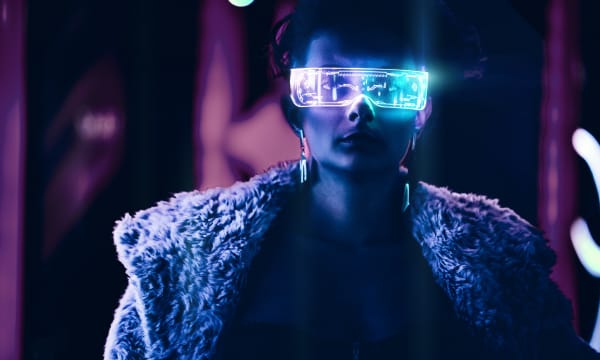So, on that note, we’d like to introduce Archie and Ellie. They are a couple in their mid-30s, and the year is 2030. As members of Gen Z, they are part of the first generation of shoppers to grow up as ‘digital natives’. For them, shopping has always been online and on mobile. They’ve always had the freedom of choice that digital shopping provides. They’ve grown up in an omnichannel world - countless brand and retailer sites, marketplaces, social channels, smart voice assistants, plus traditional shops, of course.
And as they’ve gotten older, the choice and convenience that defines digital shopping has only increased. As has the erosion of the lines between online and offline commerce.
Today, the pair are looking forward to a typical Saturday dabbling in a little retail therapy. It’s morning time, and while Ellie browses on her folding phablet over coffee, Archie makes a few enquiries of the AI voice assistant built into their smart kitchen as he makes breakfast.
Both can switch from platform to platform, account to account, without having to provide any kind of log in or verification details. This applies to making purchases, too. So, when Ellie spots a recommendation for a gig on her social feed, all it takes is a single touch of a button and the ticket purchase - payment authentication and all - is confirmed in a moment.
This is all thanks to Decentralised Identification (DID) technology, which means that Ellie and Archie both have their ID instantly recognised and authenticated biometrically by their devices - Ellie via facial recognition on her phablet camera, Archie via voice recognition. DID gives them a single digital ID that provides instant secure access to all the digital services they want to access - no more usernames, no more passwords, no more two-step authentication.
DID works by storing their personal details (including biometric data and financial accounts) in a Blockchain - a distributed, decentralised ledger system that is simultaneously completely transparent and tamper-proof. For digital shoppers like Archie and Ellie, Blockchain offers three major benefits.
For one, it’s self-verifying. A Blockchain is literally a growing chain of digital transactions, with each new ‘block’ verified only if it presents a consistent data link to what has gone before. So, Ellie and Archie’s identities can only be verified using data that is intrinsically linked to them - their biometrics, their devices, the confirmed locations provided by those devices and so on. No one else could possibly imitate them. That’s what allows for a one-stop verification process like DID.
Second, Blockchain is intrinsically secure, with each block in the chain cryptographically locked and time-stamped. That gives Archie and Ellie complete peace of mind that their data cannot be stolen or misused. And finally, Blockchain gives Archie and Ellie complete control over their personal data. It belongs to them and them alone, they only share the information they want to share or that it’s absolutely necessary to share with third-party services.
This is the world of Web 3.0, a world where Big Tech no longer controls access to digital services, where commerce takes place directly between consumers and businesses without the need for intermediaries such as payment gateways.
As Archie makes breakfast, he asks the AI assistant to make a grocery list. In an instant, the watch checks in with the smart home sensors in the refrigerator, freezer and cupboards, and displays a list of things the couple need on the kitchen’s multiscreen - bread, milk, cereal, juice etc. Checking Archie’s diary for the day, the AI suggests Archie pick the items up from the local store to coincide with his morning run, rather than have them delivered.
After Archie confirms, the smart assistant checks with the store’s online inventory that it has everything on the list in stock and then places the order. Archie will simply need to walk into the store, pick up his pre-packed bag and walk out. The store’s systems will identify Archie from the DID signature on his smartwatch as soon as he walks through the door. Payment will be triggered from his account when he walks out again.
Ellie, meanwhile, has had her eye on a new dresser unit for the bedroom. She reviews her recent searches, the machine learning algorithm in the search engine automatically ranking the items she has viewed according to her search criteria - not anything to do with the SEO efforts of the vendors. In Web 3.0, search is neutral, driven by Semantic Networks that collate data based on user intent, not the obscure algorithms of a third party like Google.
Ellie looks at the top three choices. She touches a photo of each in turn, and holds her phablet up, camera pointing at the spot she pictures the dresser fitting into. So convincing is the photorealistic Augmented Reality (AR) projection of the dresser onto the bedroom as Ellie looks at her screen that, if Ellie was shown any of these as a photograph, she would assume the dresser was already a part of the furniture.
Having tried all three, Ellie knows which one she likes the look of best. It is a second-hand piece of furniture from a private seller, made of teak. Ellie wants to be sure the timber came from a sustainable source, so she checks the Non-Fungible Token (NFT). An NFT acts like a Blockchain-based certificate of authenticity. As such, this one contains the entire history of the dresser - when the current owner bought it, who they bought it from, who manufactured it, where the materials were sourced from etc.
Able to access the certified, time-stamped purchase record for the timber within the NFT, Ellie sees the sustainability marque. Satisfied, she happily completes the purchase.
After breakfast, Archie heads out for his run. But soon after he leaves, Ellie suddenly remembers the dress she saw in the window of the boutique round the corner from the convenience store. She quickly grabs her VR headset, puts it on and enters the Metaverse
- a virtual rendering of the real world where people can interact in a shared digital space as they would physically.
Ellie takes herself to the virtual version of the boutique - the dress is still there. She calls Archie and asks if he would pick it up for her. By the time he gets there, Ellie has already been in touch with the store and requested a virtual fitting. By sharing her dimensions with the store (all contained within her DID), the sales assistant simply sends a 3D digital image of the dress to Ellie, and she can see how it fits her avatar in the metaverse, with everything scaled with pinpoint accuracy to how it would look in real life


